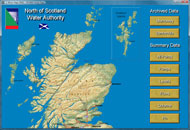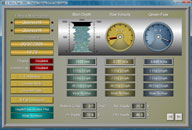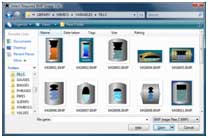| |
Graphic Workstation User Interface
OPUS SOFTWARE presents AGWS6, the sixth generation
of Advanced Graphic Workstation software. AGWS6 provides a sophisticated
graphical interface to PC6-SQL for the display and analysis of
real-time text and graphical information.
Connectivity
 Both integrated and external workstations are supported.
The integrated workstation resides on the PC6-SQL computer system
and communicates via an internal link. External workstations communicate
with the PC6-SQL system via various forms of asynchronous link,
including local and wide area networks, wired or wireless links. Both integrated and external workstations are supported.
The integrated workstation resides on the PC6-SQL computer system
and communicates via an internal link. External workstations communicate
with the PC6-SQL system via various forms of asynchronous link,
including local and wide area networks, wired or wireless links.
The workstation software is supplied free issue, the number
of users on a system being controlled solely by the PC6-SQL licensing.
PC6-SQL supports multiple users, accessing the system
either directly or through one or more workstation servers. Multiple workstation
servers can be installed to support a practically unlimited number of
users without any appreciable degradation of system performance.
User Defined Setup
Connections with multiple named sites can be established
using pre-configured 'User Defined Setup' files. These files define all
operational parameters for the connecting link, any required privilege
levels and directory paths (unique paths for the site's mimic, map, graph
and template specification files etc.).
Mimic Pages
 Mimics are typically used to customise the operator interface
or depict plant information in a graphic, or schematic form. AGWS6
mimics can also be treated as templates allowing the same page to be reused
for different sites or plant areas. Mimics are typically used to customise the operator interface
or depict plant information in a graphic, or schematic form. AGWS6
mimics can also be treated as templates allowing the same page to be reused
for different sites or plant areas.
Mimic pages consist of a background superimposed with static,
marker, control and live data items. The background can be rendered using
either a solid colour, one of the various graduated fills (18 off), or
using a specified image (e.g. an associated map, plan or photograph of
the plant).

Various static items can be inserted onto a page including
text, frames (2D or 3D shapes), titled boxes, pipes, tanks, cutout overlays,
bitmap images and icons. Pipes, text frames and bitmaps can be animated.
Markers can be inserted onto a page and provide operator
interaction using simple mouse clicks. These markers, or mouse hot spots
can be inserted using either hidden points, hidden boxes, or visible mouse
buttons. The mouse cursor automatically changes to a pointing hand symbol
whenever the cursor rolls over a marker.
 Separate
commands can be associated with a marker's active and latched states.
These commands can be used to provide links to Microsoft compatible packages
(MS Access, MS Excel, Media Player etc.), to activate utility or user
programs (e.g. Visual Basic control applications), to display other mimic
or map pages, to display other directory or summary information, to display
graph data, in fact to perform any desired display or control action. Separate
commands can be associated with a marker's active and latched states.
These commands can be used to provide links to Microsoft compatible packages
(MS Access, MS Excel, Media Player etc.), to activate utility or user
programs (e.g. Visual Basic control applications), to display other mimic
or map pages, to display other directory or summary information, to display
graph data, in fact to perform any desired display or control action.
User prompts can be associated with mimic markers, appearing
as text messages at the bottom of the display and if desired, announced
verbally by the workstation. An extensive variety of mouse buttons are
provided in the workstation's object library.
Live data items are used to represent the system's telemetry
data, current mode of operation (e.g. a data acquisition channel's modem
or polling state) and alarm status (presence of unacknowledged alarms).
Live data can be presented in a wide variety of forms including descriptive
text phrases, analogue and totalised values, bit-mapped colour coded symbols
(of any complexity or size), regular and irregular fills, gauges, sliders,
pipes and graph plots. Animations can be used to depict plant operation
or motion, illustrate conditional flow along pipes etc., thereby bringing
your mimic pages to life.
|

![]()


